 |
|
 |
2023
July
29
|
Here comes turnkey astrophotography
Right, I said "turnkey," not "turkey." In industry, a "turnkey system" is a machine already
built, configured, and installed so that all you do is "turn the key" and it works,
as opposed to an system that you custom-build.
It is time for that idea to come to astrophotography.
We've come a long way from the 1970s, when amateur astrophotography was 90%
creative reuse of materials and equipment designed for something else.
Today, we use purpose-built equipment, heavily computerized.
For many amateurs, including myself, the thrust of the hobby is putting components
together and staying on the cutting edge of technology.
But there is another way.
We're no longer having to experiment to find out what works.
Why can't you buy a telescope-camera system that has already been designed and optimized,
and has the knowledge of how to take pictures built into its computer?
You can. My good friend Douglas Downing has bought a
Vaonis Vespera, one of several new
turnkey systems for astrophotography. These are now commonly
called smart telescopes.
And with it, he took this:
|

Nebula M8, by Douglas Downing.
Stack of 60 10-second exposures, 50-mm aperture.
|
| |
One big advantage of a turnkey system is that the parts of it are all optimized for the same job,
and none of them are bigger or more expensive than necessary,
so the whole thing is small and light.
The Vespera has a 50-mm-diameter quadruplet lens and a high-quality CMOS sensor,
built into what looks like a miniature telescope (or maybe lunchbox) on an alt-azimuth mount.
That's right — alt-azimuth, no polar alignment, no guidescope. The Vespera takes short exposures and stacks them.
They are short enough that tracking and field rotation are not a problem.
And its built-in computer recognizes what it's aimed at, using a built-in star atlas, and automatically
finds the object you're photographing.
50-mm aperture? 10-second exposures? Yes — we're living in modern times!
Compare to film, digital sensors are 5 times as sharp and as much as 100 times as sensitive to light.
A very effective astrocamera can be quite a small setup.
You used to need a 12-inch telescope to have any hope of photographing spiral structure in galaxies.
Not any more!
In fact, compared to this, my own, more traditional, setup looks painfully like a digital retrofit of a film photography setup.
I could use film in it easily if I had to. My camera is a DSLR modeled on a 35-mm film camera.
My telescopes and lenses are like those used in the film era. Maybe it's time for a change.
But wait a minute. With a pre-built system like the Vespera, where's the creativity?
Doesn't everybody get the same pictures?
Only if they want to.
There are plenty of new things to do every night. The sky itself is changing.
When a nova or comet is reported, you can easily get current observations of it.
In fact, a fleet of Vesperas, or even just one of them programmed to carry out an observing program,
would be a great way to monitor variable stars and patrol for novae and comets.
I wonder what other uses they will have.
The main thing is that with a turnkey system, you get to think about astronomy —
"let's photograph this patch of sky and see what's in it" — while if you do things my way,
it seems you spend most evenings trying out a newly updated version of some piece of software!
Permanent link to this entry
Odd New Testament Greek word of the day
Odd New Testament Greek word of the day: glōssokomon
(γλωσσόκομον), the money bag that Judas carried (John 12:6).
Why does it start with the word for "tongue" or "language" (γλῶσσα)?
The dictionary in the back of the UBS5 GNT says misleadingly that it is formed from γλῶσσα and κοσμέω 'adorn'.
So how did a money box get to be called a tongue-adorner???
It turns out that's wrong. It is from γλῶσσα and κομέω 'take care of'
or κομίζω 'carry, receive' (same root).
And the reed of a musical instrument was often called a 'tongue'.
So a γλωσσόκομον was a small bag for carrying reeds for musical instruments, later broadened to be a small bag
or box used for other purposes.
If the UBS5 intended to say κομέω (which is not a New Testament word), then κοσμέω (a much more common word)
is an obvious typographical error for it. (See, now I'm doing textual criticism on the dictionary.)
There's no spiritual lesson here, but it's what sent me on a 30-minute quest when I was reading my New Testament today.
Permanent link to this entry


|
2023
July
26
|
Happy anniversary!

July 25th never goes unmarked in our household, even if I am late uploading the blog entry.
Don't worry, we didn't forget to celebrate!
This is our 41st, and what struck me this year is that more than half of our marriage
has now been after the heart surgery that Melody almost didn't survive in 2001.
I'm glad to still have her! No one is guaranteed any time, but we are especially
glad to have "borrowed" twenty-two years now.
Permanent link to this entry
Astrophotography on July 24
Every year, we have a two-month-long spell of cloudy weather in June and July, and on the 24th
we finally had a good clear night. The moon was in the sky, interfering a little with my view of
fainter objects, so I did the obvious thing: When life gives you moonlight, make moon pictures!
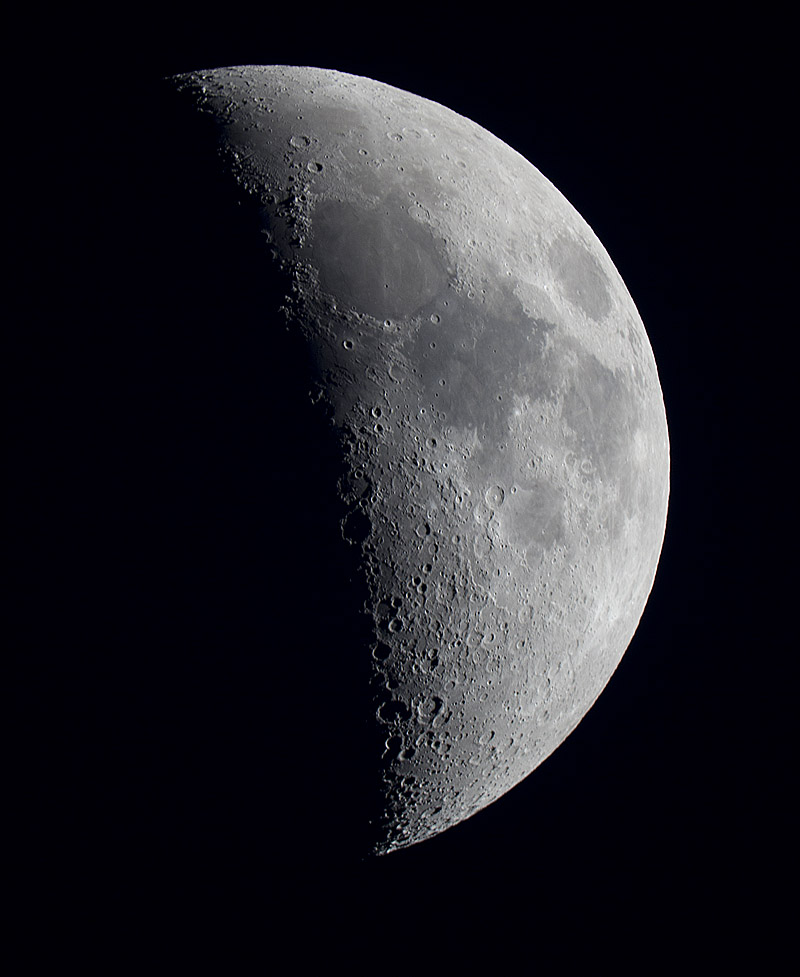
This is a single exposure with a Celestron 8 EdgeHD, f/7 compressor, and Canon 60Da.
That big a telescope was overkill for a picture like this, but it did give a good result.
Permanent link to this entry
Messier 71
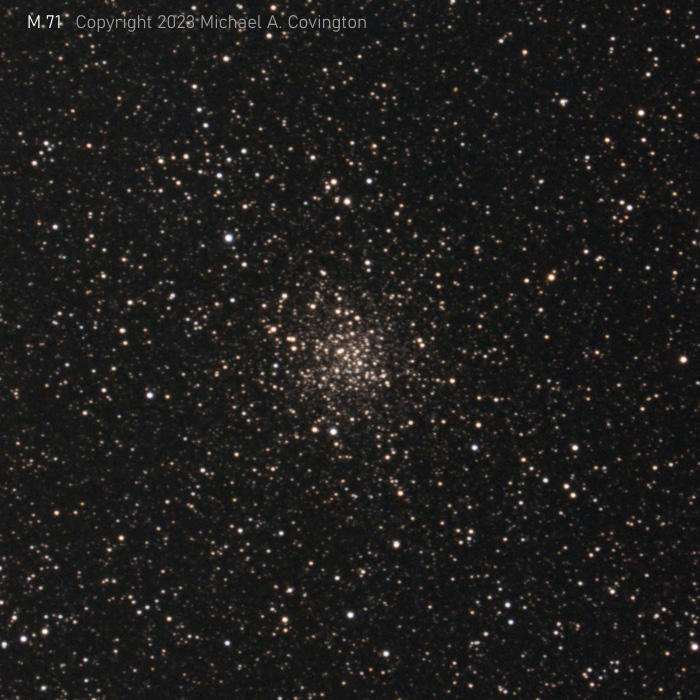
My first deep-sky image in eight weeks is the sparse globular cluster M71.
I've photographed this before; my whole routine at the moment is
"teaching new dogs old tricks," replicating older successes with new equipment
and software, since the Losmandy mount has only been here a year,
and I am now controlling the camera with N.I.N.A. rather than using it standalone.
Software versions change fast, and I may never get quite settled into everything
until the pace slows down!
Stack of fourteen 2-minute exposures, Celestron 8 EdgeHD, f/7 compressor,
Canon 60Da, and Losmandy GM811G mount, with N.I.N.A. and PHD2 software on a
ThinkPad P17. Yes, my big, heavy P17, because my T190s is about to go in for a repair,
and I wanted to get the bigger laptop set up for telescope control.
It worked fine, although some aspects of cable management and focusing were
not perfect here. I tuned everything up before taking the picture of NGC 6888
that follows.
Permanent link to this entry
Crescent Nebula (NGC 6888)
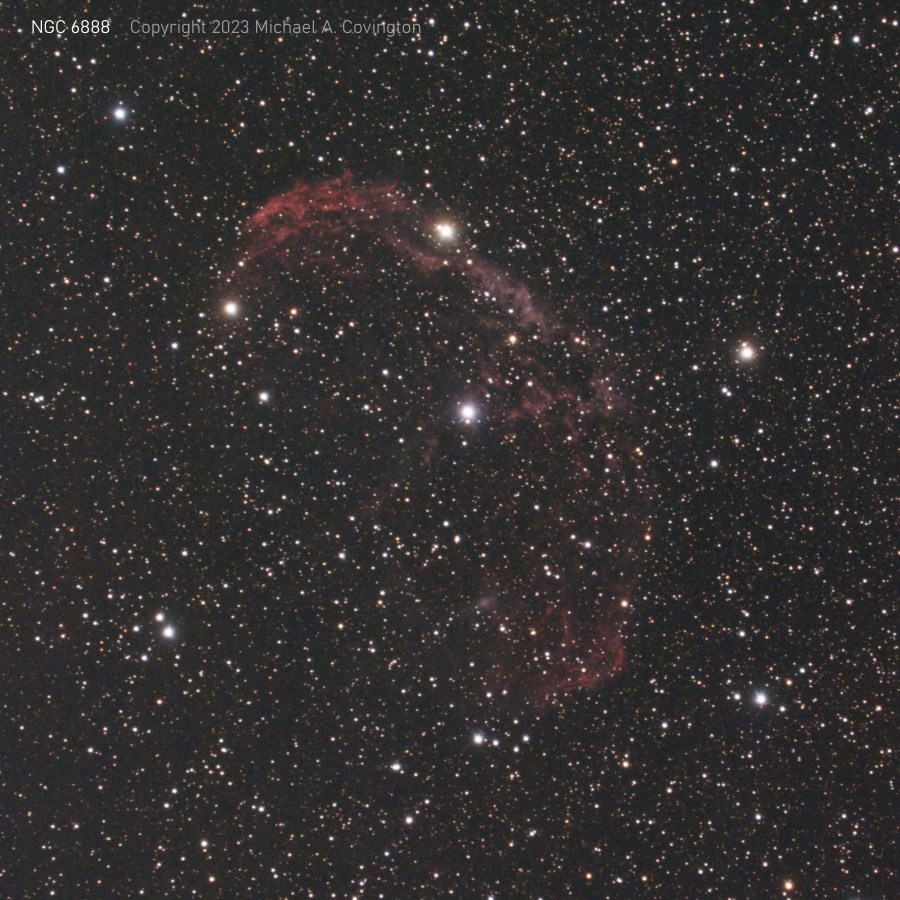
Same setup as above. This is a stack of 33 2-minute exposures.
This is very similar to a picture I took 2 years ago
with the same telescope and a different mount and different camera body.
I wonder if there is any visible difference. I took more exposures for this one,
but on the other hand I had some moonlight interfering this time.
Permanent link to this entry


|
2023
July
22
(Extra)
|
How to photograph the moon with your DSLR
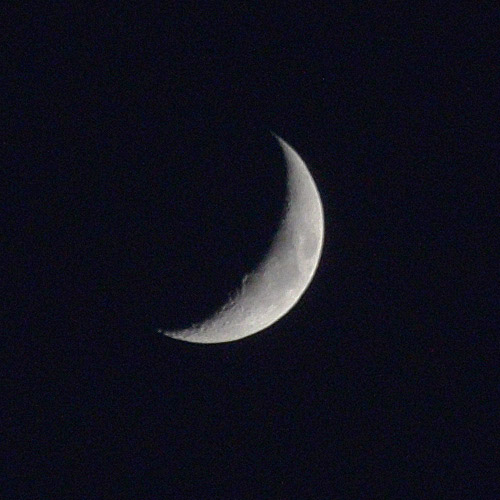
This is an extended answer to a question asked by our friend
Scott Pope, cloudscape artist.
The moon is in the evening sky now, and you may want to take a picture of it.
Here are a few tips. I assume you know how to use your camera and have the
instruction manual in case you need to use unfamiliar features.
Focal length: 100 to 1200 mm. The picture above was taken with a Nikon 18-105mm
zoom lens at 105 mm, then cropped. That is not really enough.
For excellent moon shots I use telescopes with focal lengths between 800 and 1200 mm.
Your zoom lens won't do that, but you may have a 300-mm telephoto lens that can do
surprisingly well.
Tripod, because you need all the steadiness you can get, even at 1/500 second.
Also, use delayed or remote shutter release.
Manual focus, because autofocus is probably not precise enough.
Focus in Live View, magnified.
Manual exposure (important!) because the auto exposure system doesn't know if you're
interested in the bright moon or the dark background. As a starting point, I suggest
ISO 400, f/8, 1/500 second, but increase or reduce the exposure as needed as you view
your pictures.
Sharpen or Unsharp Mask in Photoshop to bring out detail on the moon.
If you want the sky or clouds to show up, they must be quite bright.
The moon is much brighter than the things around it, and your camera cannot take in the
brightness range that your eye does. HDR techniques may help.
One last thing. Artists often paint the moon surrounded by stars.
Have you noticed that you have never seen this in real life?
The moon is so bright that it makes the sky glow around it and doesn't let you see the stars.
At best you can see stars that are some distance away from the moon in the sky.
Permanent link to this entry


|
2023
July
22
|
They want you to be second-rate
[Updated.]
Growing up, Melody and I were both bothered by two common middle-class attitudes,
which are strikingly parallel:
(1)
"Be a good churchgoer, but don't be more than slightly religious outside of church."
(2)
"Get good grades, but leave your intellectual interests at the schoolhouse door at 3 p.m."
[Added:] And a third one:
(3)
"Go to college for the social status and employability, but don't come back
thinking any differently than people who haven't been to college."
We all know people whose college education doesn't show, and that's what's behind it.
The underlying notion was of course that if you were serious about either your
religion, or your intellectual interests, or your knowledge of the world around you,
it would embarrass people who weren't aiming as high.
And it might make you outperform them on something they claim to consider important.
We can't have that.
An important middle-class value was not standing out.
My most important advice for people entering college is to drop (2) and (3).
Own your goals. College isn't tedium that your parents or the state are making you endure.
Nor are the classes just an excuse for coming here for the recreation.
If you aren't really interested in your studies, get out of the way so we can let someone in
who is.
As for (1), it's obviously a call for hypocrisy. (Either act like you believe
in God, or admit that you don't.) And thereby hangs a tale.
Very early in our dating relationship, one of the tests I was applying to Melody was whether she would
let me say grace, visibly but not conspicuously, when eating out in a restaurant.
I knew people who were firmly against that ("it makes you look like a fanatic").
But I'm the kind of Christian who does it.
I found out much later that she had been applying the same test to me. We both passed.
Permanent link to this entry
The alcohol-free option
Someone on LinkedIn wrote about having just had an "alcohol-free wedding," which
is apparently an up-and-coming trend. Here's my response:
An alcohol-free wedding is a GREAT idea. (Mine was.)
That makes it a celebration for all your friends and family, not just a party for the ones who want to drink.
Few of us realize how many people have medical restrictions on drinking,
due to anything from diabetes to certain antibiotics.
Those people get tired of being singled out or cajoled to "just have one drink" as if it weren't risky.
The same goes for people who just don't want to drink.
A good hostess will provide an alcohol-free option, all the time, without embarrassing people.
We respect gluten-free and vegan diets; why not alcohol-free?
Permanent link to this entry


|
2023
July
21
|
"Whoso draweth this dipstick from this engine..."
Our 2012 Ford Escape was probably yesterday's most amusing case at
Classic City Motorworks.
A couple of weeks ago, the handle of the oil dipstick broke off.
It was just before the Kentucky trip, and a mechanic at the Ford dealer told me
the valve cover would have to be taken off, and they couldn't do it for
several days.
They also reassured me that what was left of the handle would hold it in place,
so the repair wasn't an emergency.
Yesterday Tracy at Classic City Motorworks
fixed it.
He didn't have to remove the valve cover or drop the oil pan; he threaded a screw into the soft
plastic and pulled it out, like King Arthur pulling the sword out of the stone.
Then we had to wait one more day for the right replacement dipstick to arrive
from Ford, and today we brought it home.
I thought of attempting the screw trick myself, but if anything had gone wrong, I would not
have been able to do anything else, so it was well worth it to have it in the hands of a mechanic
who could take as much of the engine apart as necessary.
Permanent link to this entry


|
2023
July
16
|
Conservative, liberal, or what?
As the American political landscape continues to shift, here's a message
for my fellow Christians, previously posted on Facebook.
Fellow Christians: How many of you believe one or both of the following?
(1) Christians should be as conservative as possible on political issues.
(2) To help the right side win, it's OK to exaggerate or distort facts, and to pass along claims that you're not completely sure are true.
Well, (2) is just plain sin ("Thou shalt not bear false witness") and must be repented of.
This applies to what you tell yourself, not just what you tell other people.
What makes you feel righteously angry is not necessarily what is true.
And (1) is a mistake. "Conservative" and "liberal" describe how you are positioned compared to other people and recent changes.
Christian values do put you on the conservative side of some important issues, relative to the mainstream of American politics.
But that does not mean being an extreme conservative brings you closer to God.
It gets you tangled in lots of ungodly things.
In some environments (such as a fascist country), it would put you squarely on the side of evil.
When Goldwater said, "Extremism in the defense of liberty is no vice," he was dead wrong. Extremism — that is, going for extreme positions
because they are extreme rather than seeking the best and most truthful — is always a vice.
I follow Christ, not secular conservatism.
Permanent link to this entry


|
2023
July
12
|
Another grand trip
The Daily Notebook hasn't died; we've been busy.
For the first time in four years, I've been to Kentucky to see the
grandchildren, including one I had not yet met!
We (all of them, plus me) are co-authoring a book about electrical experiments
for young people. Here you see Ben doing Experiment 1, which works just the way
the (unfinished) book says.
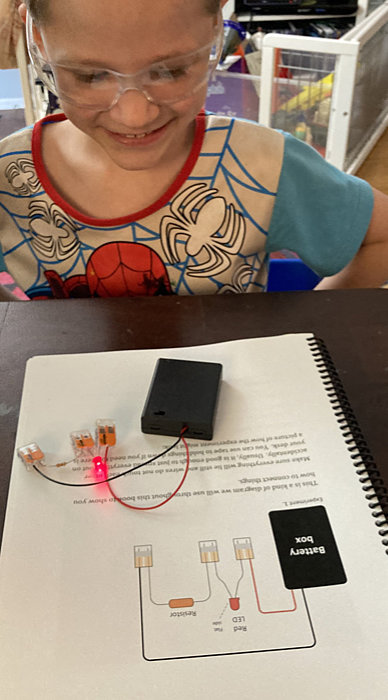
Note the Wago connectors. They are the best way I've found for children (and adults)
to connect wires, and disconnect them later non-destructively.
Permanent link to this entry
And what else should the United States be famous for?

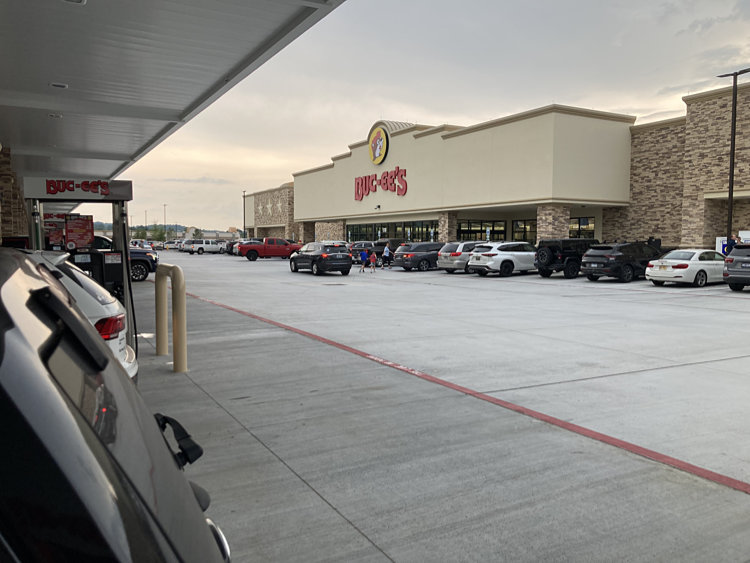
On the way up, we visited, near Sevierville, Tennessee, the largest gas
station in the world. What could add more excitement to an all-American vacation?
It belongs to the Buc-ee's chain, has 120 gas pumps
(some of which are numbered in the 240s, so I wonder what's going on),
and will soon be outdone by an even larger Buc-ee's in Texas.
Here is my party-pooper observation: Apart from a lot of very rich ready-to-eat foods,
I couldn't see that it offered anything that I might want and couldn't find at a much
smaller gas station or convenience store — and get in and out more quickly.
So I'm afraid I'm not a loyal Buc-ee's fan. But we did buy gas there.
Answer: From correspondents I hear that clean rest rooms are
a reliable attribute of Buc-ee's, and that there are many good food items I overlooked.
The variety of foods may be a godsend to travelers who have been subsisting on gas-station meals.
Permanent link to this entry


|
| |

|
|
|
This is a private web page,
not hosted or sponsored by the University of Georgia.
Copyright 2023 Michael A. Covington.
Caching by search engines is permitted.
To go to the latest entry every day, bookmark
https://www.covingtoninnovations.com/michael/blog/Default.asp
and if you get the previous month, tell your browser to refresh.
Portrait at top of page by Sharon Covington.
This web site has never collected personal information
and is not affected by GDPR.
Google Ads may use cookies to manage the rotation of ads,
but those cookies are not made available to Covington Innovations.
No personal information is collected or stored by Covington Innovations, and never has been.
This web site is based and served entirely in the United States.
In compliance with U.S. FTC guidelines,
I am glad to point out that unless explicitly
indicated, I do not receive substantial payments, free merchandise, or other remuneration
for reviewing or mentioning products on this web site.
Any remuneration valued at more than about $10 will always be mentioned here,
and in any case my writing about products and dealers is always truthful.
Reviewed
products are usually things I purchased for my own use, or occasionally items
lent to me briefly by manufacturers and described as such.
I am no longer an Amazon Associate, and links to Amazon
no longer pay me a commission for purchases,
even if they still have my code in them.
|
|









